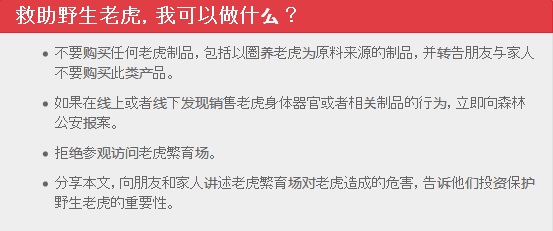China’s tiger farms are a threat to the species



In a thickly forested mountain valley in north-east China in 1986, eight tigers emerged from transport containers to find themselves in new and unfamiliar territory. Born in American zoos, these tigers had recently been shipped to China on the understanding that they would form the basis of a new captive breeding programme, to benefit the conservation of the species.
Instead, they were to become the founding population of China’s first commercial tiger farm. They had been brought together by the Ministry of Forestry at a fur farm in Heilongjiang province to establish the Hengdaohezi Breeding Centre, founded as a Government-funded operation to breed tigers for profit and supply bones for medicinal use. It has since been implicated in trade in tiger products and also functions as a tourist attraction. The move marked the beginning of a cruel chapter in the history of their species, which was to have a devastating impact on tigers across the world.
By the 1980s, after decades of systematic persecution, wild tigers were almost extinct in China. This also caused a decline in the supply of wild tiger body parts within China for use in traditional medicines. As continued demand in China fuelled a poaching epidemic across other tiger range countries, Government and private profiteers seized upon a business opportunity: large-scale breeding of tigers in captive facilities to supply body parts to the traditional medicine industry. From the outset, the tigers in China’s tiger farms were commodities, to be slaughtered and sold off for profit.
Fast-forward three decades. There are now 5,000-6,000 tigers kept in more than 200 facilities across China. Among these are large-scale farming operations, including the Harbin Siberian Tiger Park and Xiongsen Bear & Tiger Mountain Village in Guangxi, each of which now holds more than 1,000 tigers. Captive tigers are also kept in smaller facilities across the country, from ‘zoos’ and circuses to backyard enclosures.
Many of these tigers are kept in horrific conditions, in cramped concrete enclosures without any kind of mental stimulation. Many captive tigers exhibit symptoms of severe mental and physical distress and genetic deformities suggest serious in-breeding. Recent footage from Chinese zoos and other facilities has revealed emaciated, starving tigers; obviously sick tigers in tiny, squalid enclosures; and the use of cruel restraining techniques to allow paying customers to pose for photos sat atop a tiger.
There are fewer than 4,000 wild tigers left on Earth – a decline of 96 per cent since the start of the 20th century. The main reason for this decline is poaching to feed Chinese demand for their skins, bones and other body parts.
As the number of captive tigers in China has skyrocketed, wild populations have been in freefall. The tiger of Chinese literature and legend, which once prowled the hills and valleys at the heart of the country, has never recovered from the slaughter of the 20th century when wild tigers almost entirely disappeared from China. A tiny population clings on in the remote north-east of the country, along the Russian border, with numbers ranging from seven to 27 animals.
.
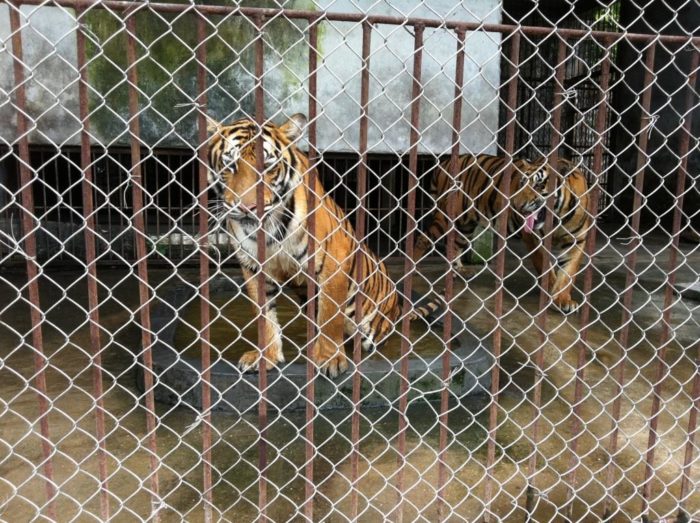
Captive tigers, Gulin, China, 2011 (c) EIA
.
Elsewhere in Asia, tigers have followed a similar trajectory. Populations in Vietnam, Laos and Cambodia are now functionally extinct, with no evidence of breeding. While tiger populations are stable or increasing in some other countries, such as India, the poaching of wild tigers to feed Chinese demand for their body parts continues at an alarming rate.
Clearly, an explosion in the number of captive tigers has done nothing to stop the killing of wild tigers. Instead, the tiger farming industry has sustained and stimulated demand for tiger parts, driving devastating poaching of wild tigers, which are preferred among consumers of bone, and hastening their march to extinction.
China’s tiger farms make frequent appearances on social media and in the news. Just this month, the announcement of tiger births at Hengdaohezi Breeding Centre was widely shared, accompanied by beguiling images of the young animals.
Often included in these articles are claims from staff at the facilities that the tigers are part of a conservation breeding scheme, with the aim of releasing tigers into the wild. In truth, the animals held in these places are treated as commodities, kept for the sole purpose of making money. Not one tiger bred in a tiger farm has ever been released into the wild.
At many facilities in China, visitors can pay to get close to tigers by taking bus ‘safaris’ through enclosures or posing for selfies with tiger cubs or sedated adults. Videos from Harbin Tiger Park show tigers living in unnatural ‘herds’. Visitors can pay to feed the animals and can witness live animals being killed and devoured by as many as 20 tigers at once. There is nothing natural about such behaviour.
Wild tigers are solitary creatures that depend on their hunting skills to survive. While these captive tigers may share the same inherent ability to kill as their wild brethren, they have not learnt the skills of what to kill. Tigers that have been raised in these environments will kill whatever is quickest and easiest upon release, be that livestock or people. Growing up around people, they lose their fear of humans. They would pose a serious danger to local communities if released and would be condemned to a life of persecution.
The conditions under which tigers are raised in these facilities are completely different from the conditions under which orphaned wild tigers have been prepared for successful releases in India and Russia.
A huge number of tiger carcasses are kept in freezers at large-scale facilities including Harbin Siberian Tiger Park, where 200 carcasses were reported to be kept in a freezer in 2010. Stockpiling of tiger carcasses and body parts in freezers is a clear indication that these stocks are being kept for trade in the future.
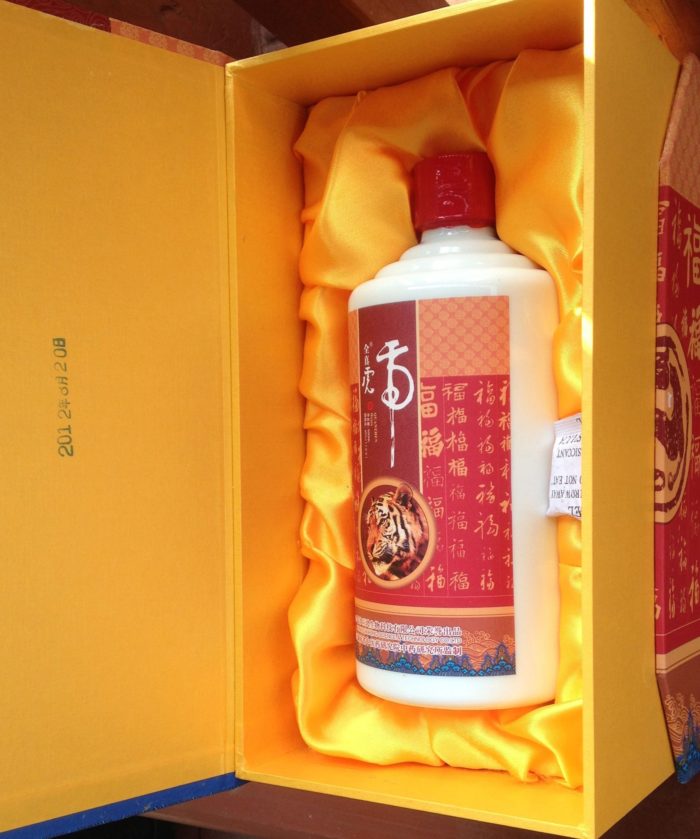
Tiger bone wine on sale in China (c) EIA
Many facilities that keep captive tigers in China have been exposed trading products made from tiger parts. The Harbin Siberian Tiger Park and Xiongsen Bear & Tiger Village have both been documented on multiple occasions trading ‘wine’ made by soaking tiger bones in alcohol. Production and trade of this ‘tiger bone wine’ has also been documented at various ‘zoos’ around the country.
The Chinese Government is apparently complicit in perpetuating the tiger trade. Despite a 1993 directive, which prohibits all trade in tiger bone and its use in medicine, tiger bone wine appears to be produced and marketed with express government authorisation under a 2005 Notification. In 2013, the Environmental Investigation Agency reported on the commercial sale of luxury rugs made from the skins of captive-bred tigers, which were being offered for sale with permits issued by the State Forestry Administration. The skins are being sold under an official ‘labelling’ system which permits legal trade in products made from protected species.
A parallel legal trade in products made using captive tiger body parts raises serious concerns about the impact of such trade on wild tigers.
Multiple real-world examples have shown that in practice, legal trade in threatened species does not take pressure off wild populations. Conversely, legal trade stimulates demand by legitimising the product in the eye of the consumer; complicates law enforcement as products from wild and captive animals are often indistinguishable; and presents opportunities for traders to launder illegal items from poached animals into the legal trade.
China’s legal ivory trade is a perfect example emphasising these concerns: the launch of a legal, permit-based ivory trade in 2004 stimulated demand for ivory, triggering a huge escalation of elephant poaching in Africa and widespread abuse of the permit system. The legal trade created a system that enabled the laundering of poached ivory.
The weak control systems and the deliberate inflation of market prices to ensure profit for the limited number of authorised dealers created a market that was undercut by cheaper illegally sourced ivory. At one point up to 90 per cent of the ivory on the market was illegal. The Government of China recognised the role the legal trade system and demand was having on wild elephant populations and committed to phasing out its legal ivory trade by the end of 2017.
.

A permit and a tiger skin rug in Xiafeng taxidermy, China, with, inset, permit details (c) EIA
.
The permit system used in legal trade of tiger products is also wide open to abuse. During an investigation in 2012, a tiger skin trader offered EIA investigators a discount if they purchased a skin without the accompanying permit, suggesting that the permit could be fraudulently re-used for other, illegally sourced skins. This could be pulled off easily, as the image on the permit was too small to accurately identify the skin to which it related.
Enabling trade in captive-bred wildlife also risks creating a parallel market for wild-sourced products, which may be seen as more desirable and effective. In a survey of residents of six major Chinese cities in 2008, a majority of people believed that parts and products from wild tigers are more effective and more desirable than those from farmed tigers.
Recent years have witnessed the emergence of tiger farming across South-East Asia. Hundreds of captive tigers are now held in commercial breeding facilities in Thailand, Laos and Vietnam. As tiger farming and trade in captive tigers has proliferated in China and South-East Asia, so too has illegal trade.
In India, 2016 saw more tigers poached than any year since 2001. The world’s last remaining wild tiger populations are paying the ultimate price to feed demand that is stimulated by Chinese policy. They simply cannot withstand this level of killing.
.
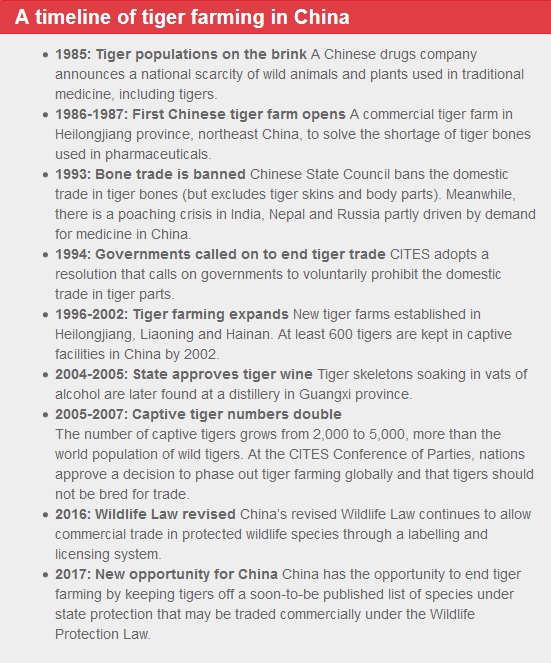
.
Tiger farming has been recognised as a serious threat to the survival of wild tigers by the international community at the very highest levels.
All international commercial trade in tigers and their parts and products is banned by the Convention on International Trade in Endangered Species of Flora and Fauna (CITES), an international treaty that China signed in 1981. Recognising that legal domestic trade within a country also stimulates demand and drives poaching, CITES passed a resolution in 1994 that called for governments to ban domestic trade in tiger products.
Subsequent decisions have reiterated that countries should ban domestic trade, and have called for the destruction of stockpiles of tiger parts and products. The threat posed to wild tigers by tiger farming has been specifically recognised; in 2007, the CITES Conference of the Parties passed a decision that tigers should not be bred for trade (including domestic trade) in their parts and products.
Tiger farms were back on the global agenda at the 2016 CITES meeting, at which the international community reiterated that tigers should not be bred for trade, agreed on a plan of action to identify problem facilities and encouraged the destruction of stocks of tiger parts. At this meeting, Laos announced that it would be the first country to phase out its tiger farms.
With fewer than 4,000 tigers remaining in the wild, every single tiger counts. In 2010 at a tiger summit held in St Petersburg, Russia, then-Premier Wen Jiabao made a statement that mentioned ending “tiger trade”. Unfortunately, this intent has not been taken up by the State Forestry Administration, which has continued to allow and promote commercial breeding of tigers and trade in their parts and products.
With the recent closure of its legal ivory market, the Chinese leadership has shown it is willing to take the action required to save a species threatened by trade from extinction. Sadly, this willingness has not yet been extended to tigers.
It’s clear that there is growing support for ending tiger farming in China. A proposal was put forward at this year’s CPPCC plenary session to end tiger trade and phase out tiger farms, and new Government plans to establish a huge reserve in north-east China for tigers and leopards, are a positive step. But until commercial breeding and trade of tigers and their parts are phased out, this policy will continue to undermine any other attempts to save China’s tigers.
The Chinese leadership now has an opportunity to build on the momentum of the ivory ban and show real global leadership in wildlife conservation, by banning all commercial breeding and trade of tigers and phasing out tiger farms. Until it does so, wild tigers across Asia are living on borrowed time.
.

.
.
..
1986年,中国东北地区一片植被茂密的山谷中,八只老虎从运输箱中走出,踏上了这片陌生的领地。当时,这些在美国动物园出生的老虎刚刚运抵中国。按照约定,中方会以这八只老虎为基础开展一项人工繁育项目,促进物种的保护。
但实际上,这八只老虎是中国首个商业化老虎繁育场的首批“住户”。这个坐落在黑龙江省一家毛皮场内的中国横道河子猫科动物饲养繁育中心曾是一家出售药用虎 骨的国营企业。现在已转为主要供游客参观的繁育中心。人工老虎繁育的兴起没有能够拯救野生虎群的衰落,反而揭开了老虎物种历史上残酷的一章。
20世纪80年代,在几十年的系统性捕杀之后,野生老虎基本在中国境内绝迹。随着老虎种群数量的减少,中药药用的老虎产品供应也相应枯竭。在此背景下,对 虎产品的需求一方面导致老虎盗猎蔓延至其他国家,另一方面,投机者抓住这一重要的商机,兴建繁育设施来大规模人工繁育老虎,为中药行业提供虎制品原料。
30年后,中国各地繁育老虎的场所超过200处,当前圈养着5000到6000只老虎。其中一些规模很大,如哈尔滨市东北虎林园和广西桂林雄森熊虎山庄,都分别圈养了超过1000只老虎。各地还有很多规模更小的人工繁育设施,其中不乏动物园和马戏团,甚至也有私人圈养老虎。
很多圈养老虎生活在拥挤的水泥笼舍里,缺乏足够的精神刺激。恶劣的生存环境也令许多老虎在精神和身体上表现出严重的焦虑症状,而虎崽的先天性畸形则是近亲繁殖的证据。一些摄于中国动物园的视频中不乏看上去憔悴、饥饿的老虎;一些明显生病的老虎被关在狭小、肮脏的空间里;另外饲养人员还会使用残忍的约束手段,让游客可以付费骑着老虎照相。
目前地球上还剩下不到4000只野生老虎,比20世纪初期减少了96%。中国对虎皮、虎骨和其他老虎制品的需求引发的盗猎活动是导致野生虎数量减少的主要原因。
中国圈养老虎的数量快速增长,野生老虎种群数量却继续直线下降。中国文学作品和民间传说中所描绘的曾经雄霸于中国腹地崇山峻岭之中的老虎,在经历了20世纪的漫长猎杀后,如今几乎已经很难在中国境内看见。仅剩一个小的种群在中国东北部与俄罗斯接壤的地区苟延残喘,数量估计仅为7到27只不等。
.

Captive tigers, Gulin, China, 2011 (c) EIA
.
在亚洲其他地区,老虎也面临着同样的命运。越南、老挝和柬埔寨的老虎种群如今已经功能性灭绝,未发现野生虎生育的迹象。印度等一些其他国家的老虎种群数量保持稳定或者有所增长,但为满足中国对老虎制品的需求而盗猎野生虎的活动仍以令人警惕的速度继续着。
显然,圈养老虎数量的激增并没有阻止对野生老虎的屠杀。相反,繁育中心的出现维持并刺激了对老虎制品的需求,导致更受虎骨消费者偏爱的野生老虎遭到毁灭性的盗猎,加速了它们的灭绝。
繁育中心时常见诸中国社交媒体或者新闻报端。仅在本月,横道河子猫科动物饲养繁育中心虎崽诞生的新闻和虎崽憨态可掬的照片就被广泛转载。
此类文章经常援引繁育场工作人员的说法,称这些老虎是保护性繁育计划的一部分,最终的目标是将它们放归自然。但实际上,很多繁育场中圈养的老虎被当做商品对待,繁育它们的唯一目的就是赚钱,而放归自然可行性存疑,目前尚无成功先例。
在很多养虎场,游客都可以花钱乘坐游览车进入饲养区域近距离观赏老虎,或者与虎崽或被施以镇静剂的成年老虎自拍。来自哈尔滨老虎公园的视频资料显示,老虎以不自然的“群集”方式生活。游人可以付钱给老虎喂食,也可以见证活体动物被多达20只老虎同时捕杀并分食的场景。而此类行为与老虎的本性相悖。
野生老虎是 掠食性独居动物。虽然这些圈养的老虎有着与野生虎一样的猎杀天性,但它们并不知道应该猎杀什么。在这种环境中养大的老虎在获得自由之后会选择猎杀最容易抓 到的东西,不管这东西是家畜还是人。它们在人类身边长大,已经失去了对人类的恐惧。如果被放归到自然环境中,它们会对当地居民造成严重的威胁,并因此注定 难逃被猎杀的命运。
虽然印度和俄罗斯都曾人工饲养失去双亲的野生虎崽,并成功将它们放归自然环境,但中国繁育场的养殖条件与这两国的情况完全不同。
大型繁育场的冷库中都保留着大量老虎的尸体。根据2010年的报道,哈尔滨市东北虎林园就保存着200具老虎的尸体。很明显,囤积的这些老虎尸体和器官都是未来交易的存货。

Tiger bone wine on sale in China (c) EIA
中国很多老虎繁育场都被曝光出售老虎制品。哈尔滨市东北虎林园以及雄森熊虎山庄均多次被曝出出售虎骨酒。全国多个“动物园”也都先后被曝光存在生产和销售“虎骨酒”的行为。
政策的反复导致了老虎制品贸易从未断绝。 1993年中国政府发布通知,严禁所有虎骨贸易,并不得再以虎骨入药,但2005年的一份《国家林业局、卫生部、国家工商总局、国家食品药品监管局、国家 中医药管理局关于试点性启用人工繁育虎骨入药和逐步减少利用豹骨的通知》(林护发[2005]139号)却似乎为人工繁育虎骨入药重新打开了门。2013 年,环境调查署(EIA)的报告指出,利用人工繁育老虎的皮制成的奢华地毯在获得了中国国家林业局的销售许可后上市出售。官方“认证”系统为包括虎皮在内的一些保护物种制品贸易赋予了合法性。
人工繁育老虎制品的合法贸易让我们不由得不担心此类贸易对野生虎的影响。
一桩桩真实的案例证明,濒危物种的合法贸易并不能减轻野生种群面临的压力。相反,合法贸易在消费者心中留下了购买此类商品没有问题的感觉,从而刺激了需 求;由于野生与养殖动物制品往往无法分辨,执法难度大大增加;此外,不法经营者可以利用合法贸易的可乘之机给盗猎获得的非法物品披上合法的外衣。
中国的合法象牙贸易很好地说明了这些问题:2004年启动的合法象牙贸易许可证制度刺激了对象牙的需求,导致非洲大象盗猎活动严重升级。同时,许可证的滥用也普遍存在。合法贸易体系还给盗猎象牙洗白提供了平台。
监管体系薄弱加上为确保为数不多的授权经销商的利益人为抬高市场价格,导致价格较低的非法象牙充斥黑市。非法象牙的市场比重曾一度达到90%。中国政府最终意识到合法贸易系统以及消费者需求给野生大象种群带来的影响,并承诺在2017年年底之前逐步停止合法象牙贸易。
.

A permit and a tiger skin rug in Xiafeng taxidermy, China, with, inset, permit details (c) EIA
.
老虎制品合法贸易的许可证制度也存在诸多弊端。2012年的一次调查中,一位虎皮商人对假扮消费者购买虎皮的EIA调查人员说,如果不要许可证的话,就可 以给予折扣。这表明,合法产品的许可证可能被重复使用于非法虎皮的贸易。这种欺诈行为易于操作,因为许可证上的照片很小,根本无法准确地辨明其所对应的合 法虎皮制品。
允许圈养野生动物制品的贸易还会催生出一个野生动物制品的平行市场,而野生动物制品由于其所谓的“功效”更受消费者追捧。2008年一次对中国六大城市居民的问卷调查显示,大多数受访者认为野生老虎的身体器官和相关制品比圈养老虎的效果更好,更受欢迎。
近年来,东南亚地区老虎繁育活动兴起。目前泰国、老挝和越南有数百只老虎被圈养在商业繁育场。随着老虎繁育和贸易在中国和东南亚地区蔓延,非法贸易也日渐抬头。
2016年是自2001年以来印度老虎盗猎数量最高的一年。中国相关政策催生的老虎制品需求正在让全球幸存的野生老虎种群付出惨重的代价。它们承受不住这样的屠杀。
.
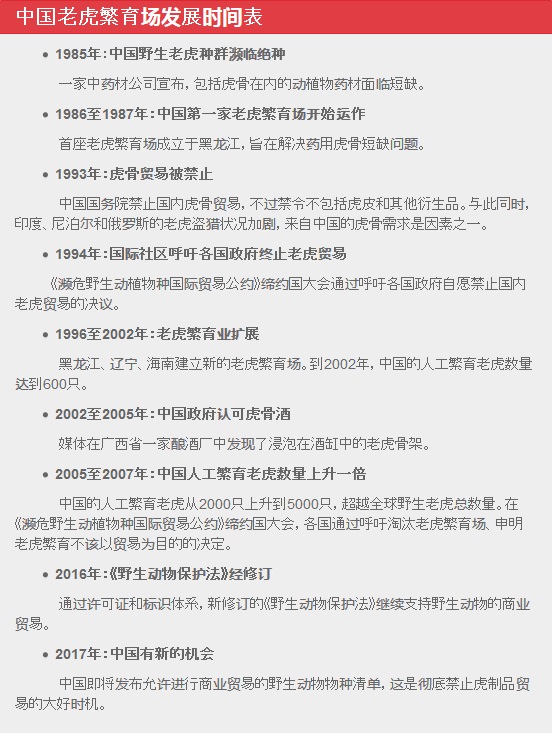
.
国际社会已经就人工繁育对野生虎生存构成的严重威胁达成高度共识。
《濒危动植物物种国际贸易公约》(CITES)禁止一切老虎及其身体器官和相关制品的商业性国际贸易,中国也于1981年签署了公约。CITES还认识到一国之内合法贸易也会刺激需求并造成盗猎,并于1994年通过决议,呼吁各国政府禁止老虎制品的国内贸易。
后续出台的决议重申,各国应禁止国内贸易,并呼吁销毁老虎身体器官和制品的存货。老虎繁育给野生老虎种群带来的威胁已经得到重视——2007年,CITES缔约方会议通过决议,指出不应以老虎身体器官或者相关制品的贸易(包含国内贸易)为目的进行老虎养殖繁育。
在2016年CITES会议上老虎繁育场再次成为国际议题。在这次会议上,国际社会重申了不应以贸易为目的进行老虎繁育的立场,就识别问题繁育场的行动方案达成一致,并鼓励销毁库存的老虎身体器官和制品。这次会议上,老挝宣布将成为首个逐步停止老虎繁育的国家。
在全球仅存不到4000只野生老虎的情况下,每一只老虎都十分珍贵。2010年在俄罗斯圣彼得堡举行的老虎峰会上,时任中国总理的温家宝在发言中提到要停止“老虎贸易”。遗憾的是,这一意愿并未得到贯彻执行,老虎商业繁育以及老虎器官和制品贸易得以继续进行。
中国领导人近期做出的关闭合法象牙市场的决定表明,中国有意愿采取必要行动,避免濒危物种灭绝。遗憾的是,到目前为止,这种意愿并未惠及老虎。
可以肯定的是,在中国,支持关闭老虎繁育场的声音日益强烈。今年全国政协全体大会上有代表提出提案,建议停止老虎制品贸易,并逐渐关闭全部老虎繁育场;中国政府新近出台的在东北地区建立东北虎和东北豹大型保护区的计划也是积极的一步。但除非老虎商业化繁育以及相关制品贸易彻底停止,否则老虎制品合法贸易的政策必将继续削弱其他拯救中国老虎的努力。
现在,中国领导层大可凭借此前象牙禁令的良好势头,出台政策禁止一切老虎商业化繁育和贸易,并逐步关闭所有老虎繁育场,在野生动物保护领域展现其真正的全球领导力。只有这样,野生老虎的生存危机才有可能得到缓解。
.
